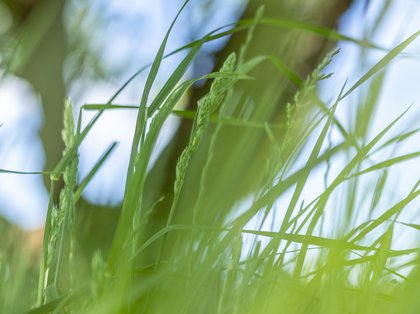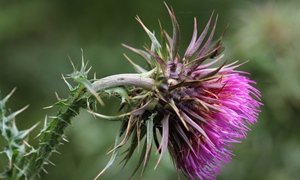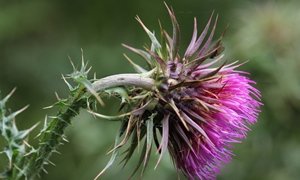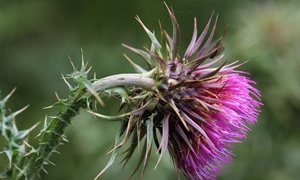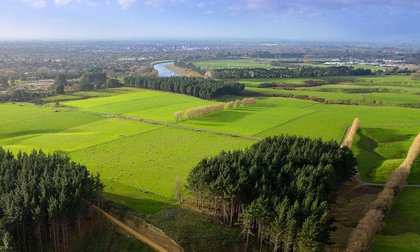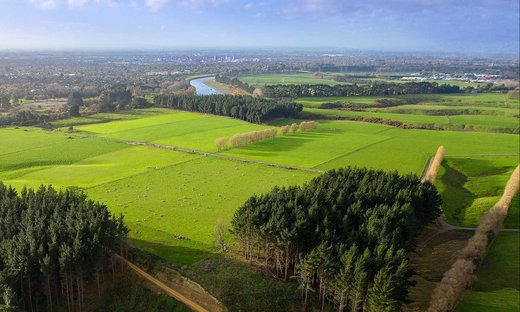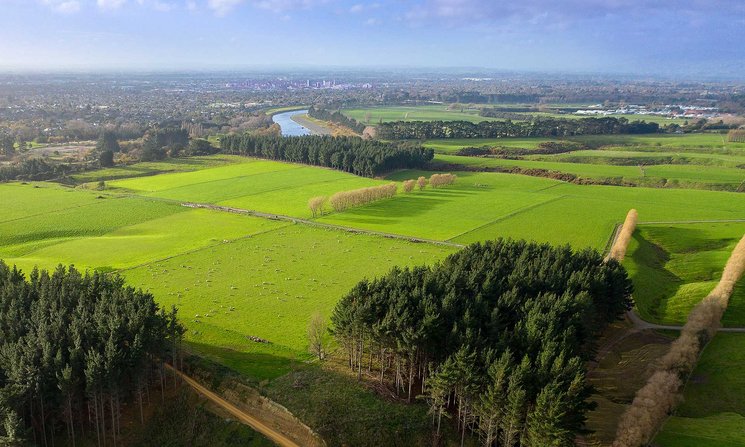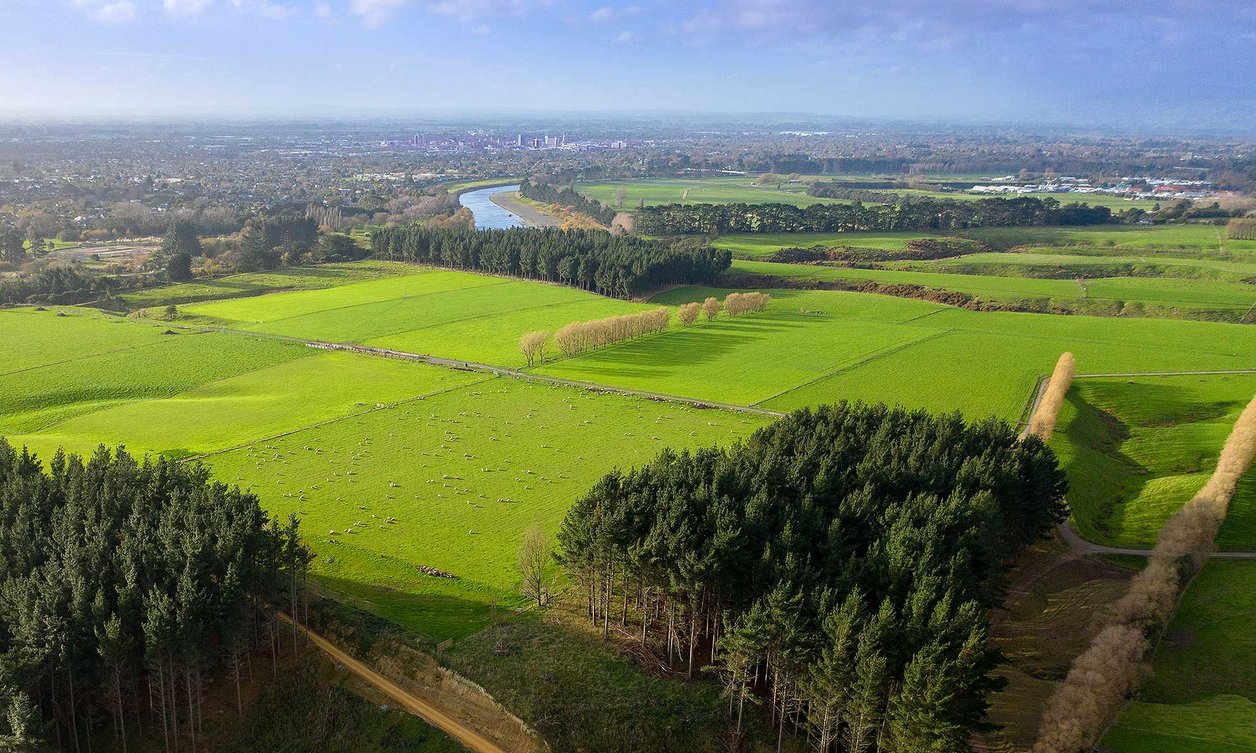Grasses
Annual poa
Annual poa
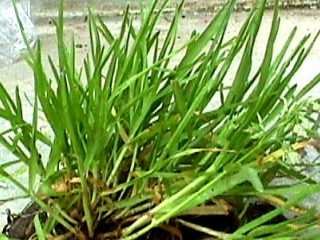
Annual poa plant
Poa annua
An annual grass, often considered a weed. Found most commonly on disturbed soil, for example, in gardens or after treading damage by stock. It is often one of the first plants to grow from bare soil in sheep yards.
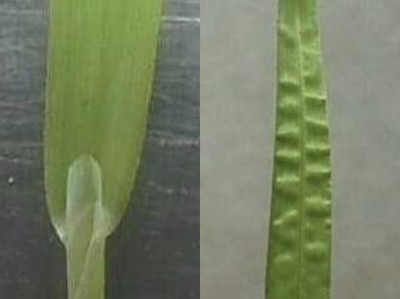
Leaves of the annual poa grass
Vegetative identification
- A small (< 15 cm) yellow-green plant.
- Leaves hairless, ligule membranous with a serrated edge, leaf blades soft and often crinkled during elongation.
- As in other poa species, leaves have a canoe-shaped tip and a prominent square groove that runs the length of the mid-rib. The lower leaf surface is not shiny as in Poa trivialis.
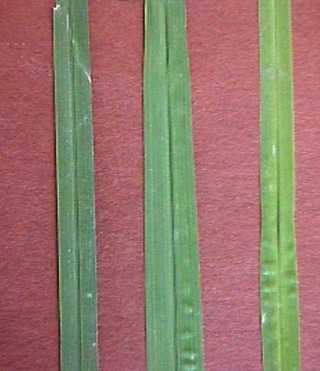
Three common poa species, Poa pratensis (left), Poa trivialis (middle) and Poa annua (right)
Leaf comparison of three common poa species
Poa pratensis is known in the USA as Kentucky bluegrass and has a darker colour than Poa trivialis. Poa annua is a yellow-green compared with Poa trivialis.
Poa pratensis has parallel-sided leaves, whereas the leaves of Poa trivialis taper along their length. Poa annua leaves often have patches of crinkled surface (see lower right).
Many poa species, including Poa annua and Poa pratensis, have canoe-shaped leaf tips (not shown here).
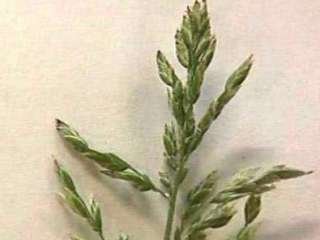
Annual poa seedhead
Seedhead
- Seedhead is an open panicle.
- Seedheads are low (< 15 cm) and often nestled among leaves.
- Flower heads appear within a few weeks of establishment and at any time of year.
Barley grass
Barley grass
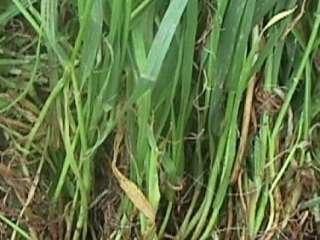
Barley grass plant
Hordeum murinum subsp. murinum
Barley grass is an annual plant common in stock camps around shelter trees, along fence lines, etc. It is found throughout New Zealand but is more common in areas where conditions are dry in summer.
Seeds have erect or slightly spreading awns with fine backwards-pointing barbs with sharp points. The awns cut into the mouths or skin of grazing animals, causing irritation and economic loss through pelt damage.
Former Latin name Critesion murinum.
Other species
- Salt barley grass (Hordeum marinum) occurs in some coastal areas.
- Several other species of barley grass have been recorded from Hawke's Bay and Canterbury.
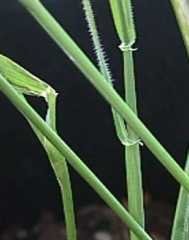
Barley grass leaves
Vegetative identification
- Sparse hairs on the leaf blade and leaf sheath are usually more easily seen on the leaf sheath, depending on the lighting.
- Well-developed auricles clasping the pseudostem.
- Bluish-green colour with soft, medium-width leaves (see plant photo above).
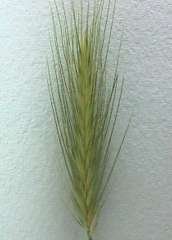
Barley grass seedhead
Seedhead
- A distinctive seedhead. The seeds are in clusters of three, termed triads.
- Taxonomically, each triad is considered a cluster of three single-seeded spikelets because the spines on each side of each seed are considered glumes.
Browntop
Browntop
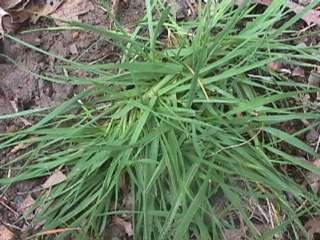
Browntop plant
Agrostis capillaris
A widespread perennial grass found in nearly all older pastures in New Zealand. A low fertility tolerant C3 grass, common in hill country pastures but also used in lawn mixtures.
Former Latin name was Agrostis tenuis.

Browntop leaf
Vegetative identification
- Bluish-green colour.
- The midrib is almost invisible.
- Ligules are very short and are inconspicuous in side view, whereas closely related creeping bent has ligules >2 mm.
- Leaf short but comparatively wide for shorter length.
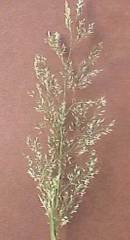
Browntop seedhead
Seedhead
- Seedhead is an open, many-branched panicle.
- Small spikelets (2 to 3 mm long).
- One floret per spikelet.
Cocksfoot
Cocksfoot
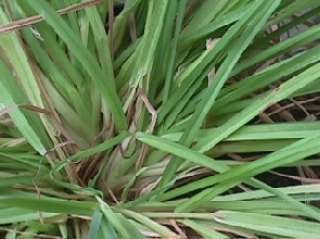
Cocksfoot plant
Dactylis glomerata
Cocksfoot is most often found in medium fertility and more laxly grazed environments, recognised as having better drought tolerance than ryegrass. It is a tightly tufted, perennial, C3 grass.
Also called "orchard grass" because longer leaves tend to dominate under laxer grazing. Often included with ryegrass in seed mixtures.
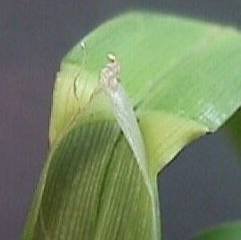
Cocksfoot ligule
Vegetative identification
- Bluish-green colour;
- Tiller strongly flattened with leaves sharply folded.
- Large "Sydney Opera House" ligule.
- Hairless with no ribs on the lamina.
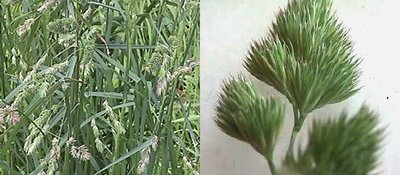
Cocksfoot seedhead (right) and plant in seed (left)
Seedhead
- Flowering plants are common on roadsides and distinctive.
- Seedhead is a compacted panicle with spikelets crowded into dense one-sided clusters at the end of short branches.
Couch
Couch
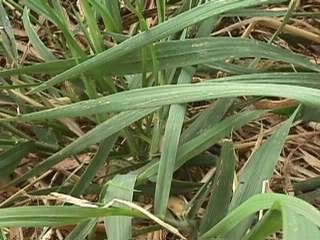
Couch grass
Elytrigia repens
Couch actively spreads by rhizome production. Therefore, it is a weed in gardens and a nuisance in cropping land when established. Under grazing or in a mown lawn, couch is uncompetitive and seldom persists.

Couch leaves

Couch rhizomes
Rhizomes are segmented, and each joint or node has a scale leaf and a bud. The dark fibres of this old rhizome are the remains of decomposing scale leaves. At the node at the left of the photo, the bud has developed into a branched rhizome.
Vegetative identification
- Dull bluish-green and lightly ribbed leaves, similar to barley grass but harsher to the touch.
- Sometimes with short, sparse hairs on the blade and/or the sheath.
- Spreading by prolific underground rhizomes.
- 2 to 3 mm in diameter, sometimes reaching 600 mm or more from the parent shoot.
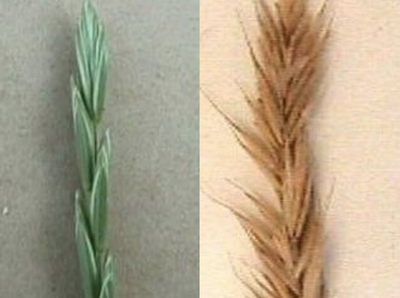
Couch seedheads
Seedhead
- The seedhead is spiked with spikelets evenly spaced along its length. At first glance, it appears a little like the seedhead of ryegrass.
- Spikelets are 'flat-side' to the stem (o |), whereas perennial ryegrass spikelets are edge-side to the stem (o –).
- Couch is a member of the tribe of grasses which includes wheat, and related grasses are called "wheatgrass" in USA. Spikelets open rather like wheat on maturity.
Creeping bent
Creeping bent
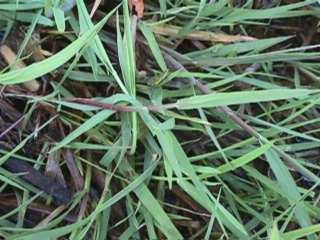
Creeping bent plant
Agrostis stolonifera
Creeping bent is distinguished from browntop (Agrostis capillaris) by creeping stems, forming patches, often a metre or more in diameter. Hybridises with other species of Agrostis to create intermediate types.
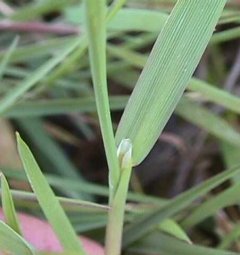
Creeping bent leaf
Vegetative identification
- Bluish-green colour, with an almost invisible midrib.
- Ligules are >2 mm, longer than those of closely related browntop.
- Prominent internode elongation of vegetative stems.
Seedhead
This grass doesn't flower often, but when it does, the seedhead is a little more compact than browntop.
Crested dogstail
Crested dogstail
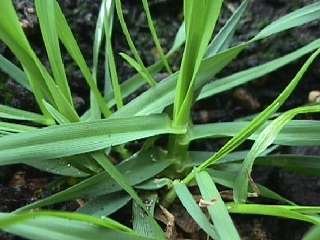
Crested dogstail grass
Cynosurus cristatus
Crested dogstail is a perennial grass found on moderate to low fertility soils, especially older sheep pastures.
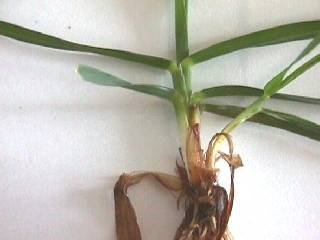
Crested dogstail leaf and tiller
Vegetative identification
- More leaves per tiller and fewer tillers per plant than ryegrass.
- The tiller base is a yellow-brown or cream colour, not red as in ryegrass.
- Leaf blades join the pseudostem at an angle near 90 degrees.
- The collar region has a yellow-coloured thickening with no auricles.
- Leaf blades shiny below, emerald green in colour, at times with a bluish tinge, ribbed.
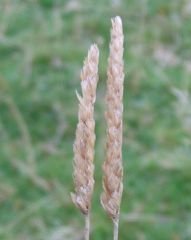
Crested dogstail seedhead
Seedhead
A distinctive seedhead. Spikelets are in two close-packed vertical rows on the same side of the stem.
Danthonia
Danthonia
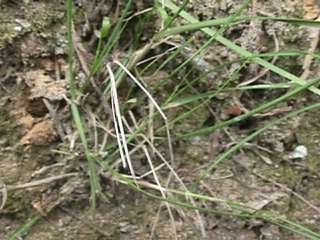
Danthonia plant
Rytidosperma spp.
A native perennial grass most commonly found near scrub or forest margins on poorer hill country, but sometimes persisting for many years on steeper banks in improved pastures. There are approximately 25 species in the genus, with wide variability in growth form. For example, leaves may be almost 10 mm wide or so narrow that the plant is similar in appearance to fine fescue.
The New Zealand common name, danthonia, is a previous Latin name, now replaced by Rytidosperma in New Zealand. In mainland Australia and Tasmania, where some species of this grass are also found, the Latin name is Austrodanthonia (wallaby grass).
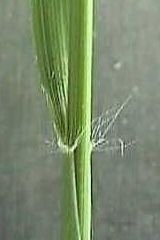
Danthonia ligule (fringe of hairs) and auricles (tufts of long hairs)
Vegetative identification
- Because of the large number of species, it is best to identify the plant by the seedhead.
- The ligule is always a fringe of hairs. In this plant, a tuft of longer hairs in place of the auricle.
- Leaves are usually ribbed and similar to ryegrass in colour.
- Usually, the plant is loosely tufted with open space between tillers.
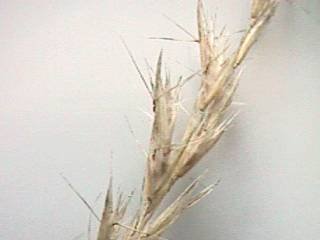
Danthonia seedhead
Seedhead
- The seedhead has many seeded spikelets, like the fescue, poa, or brome grasses. Usually, about six to 10 spikelets per head may be spaced along a single stem (a raceme) or loosely clustered on branches forming a small panicle.
- The lemma (outer scale on the seed) has three "tails", the centre one long, straight when the seedhead is immature, but twisting distinctively and protruding at an angle as the seeds develop.
- Seeds have three rows of hairs across the back of the lemma (visible with a low-power microscope). Differences in length and density are characteristics used to distinguish the different species.
Fine fescue
Fine fescue
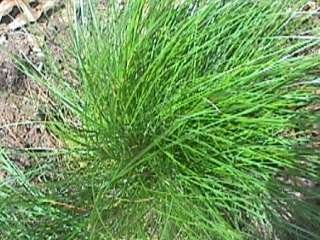
Fine fescue plant
Festuca rubra
Fine fescue is often included in previous years as a component in bush burn seed mixes and persists in many hill country pastures. Because of its dark green colour and fine texture, it is used widely as a lawn grass. A tufted form is called Chewing's fescue and a creeping form is called red fescue.
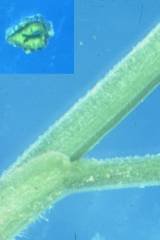
Fine fescue leaf — insert of the rolled leaf's rolled in cross-section
Vegetative identification
- Leaves rolled in cross-section, visually resembling pine needles.
- Leaves are a dark emerald green colour.
- Dead leaf sheaths at tiller base highly lignified, chocolate brown with lighter straw-coloured veins.
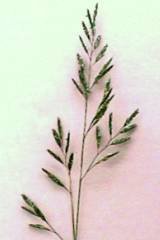
Fine fescue seedhead
Seedhead
- The seedhead is an open panicle, much smaller and less branched than tall fescue.
- Individual seeds are similar to those of tall fescue but a little shorter, often with short fine awns at the end of the lemma.
Floating sweet grass
Floating sweet grass
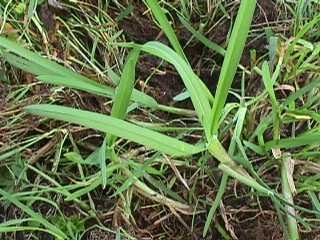
Floating sweet grass plant
Glyceria fluitans
Floating sweet grass is common in wet places such as stream edges or low-lying hollows where water gathers. Usually 10 to 30 cm high.
Other closely related species of Glyceria are also present in New Zealand. Glyceria maxima occur in swamps and grow to 1 m or more high.
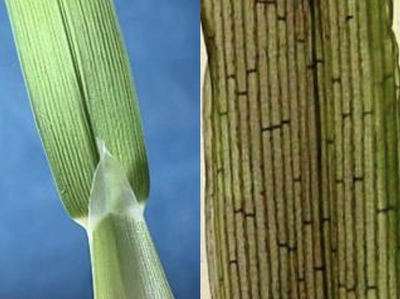
Floating sweet grass leaf
Vegetative identification
- Leaves have a flattened tiller and large ligule, similar to cocksfoot.
- Short cross-veins on the leaf sheath between the lengthwise veins are visible in good light.
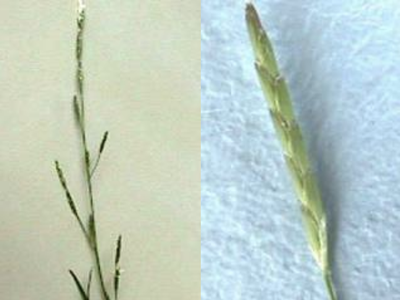
Floating sweet grass seedhead
Seedhead
- Seedhead is an open panicle.
- Spikelets of about eight florets are more or less circular in cross-section and very distinctive.
Italian ryegrass
Italian ryegrass
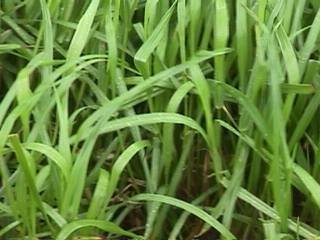
Italian ryegrass
Lolium multiflorum
Pastures usually persist for one to two years, but will show high winter growth rates and good nutritive value compared with perennial ryegrass. Italian ryegrass is included in cropping rotations, for example, as a winter forage between two successive spring-sown cereal crops.
Tetraploid varieties have larger tiller sizes. Hybrids with perennial ryegrass are intermediate between the two parents.
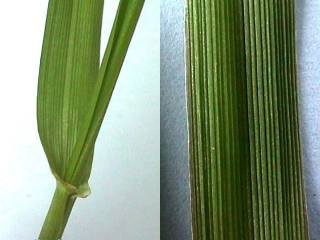
Italian ryegrass leaf
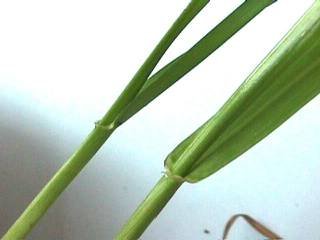
Perennial ryegrass (left) Italian ryegrass (right). Note: Italian ryegrass has a wider lamina, rolled emerging leaf and often auricles at the lamina base

The red tiller base of ryegrass. Red colouration caused by anthocyanin pigments varies from almost absent to a deep red purple
Vegetative identification
- Italian ryegrass leaf has a ribbed upper surface (a "corrugated iron" pattern) and shiny lower surface to lamina. The plant is similar to perennial ryegrass, and the ribbed leaf pattern is also seen in perennial ryegrass, tall fescue (coarser ribs) and crested dogstail.
- A rolled emerging leaf distinguishes the plant from the folded emerging leaf of perennial ryegrass.
- Leaf blades usually a little wider and yellower than perennial ryegrass.
- A red tiller base.
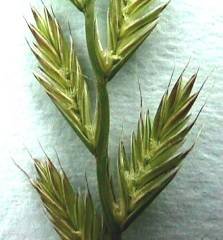
Italian ryegrass seedhead
Seedhead
- Seedhead is almost identical to perennial ryegrass, with spikelet edges pressed against the stem and protected by a glume about half the length of the spikelet.
- Fine awns on the ends of the lemma of each seed distinguish the plant from perennial ryegrass.
Kentucky bluegrass
Kentucky bluegrass
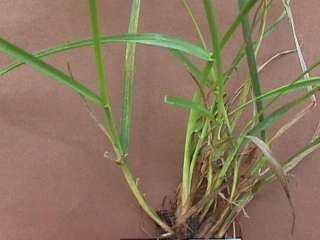
Kentucky bluegrass plant.
Poa pratensis
A perennial grass, often included in pasture seed mixtures following bush burns last century. Now uncommon but persisting in isolated patches. Sometimes it is used as a lawn grass, especially in certain parts of the eastern USA, where it is known as Kentucky bluegrass.

Kentucky bluegrass leaf and rhizomes
Vegetative identification
- Plant spreading by slender underground rhizomes. Poa annua is tufted, whereas Poa trivialis spreads by stolons above ground.
- Leaves dark green with parallel sides and a canoe-shaped tip, often with a distinct groove on each side of the midrib forming a "tramline" effect, not ribbed on the upper surface.
- Leaves are less shiny on the underside than those of Poa trivialis.
- The best way to distinguish poa species, is by the characteristics of their leaves.

Three common poa species, Poa pratensis (left), Poa trivialis (middle) and Poa annua (right)
Leaf comparison of three common poa species
Poa pratensis is known in the USA as Kentucky bluegrass and has a darker colour than Poa trivialis. Poa annua is a yellow-green compared with Poa trivialis.
Poa pratensis has parallel-sided leaves, whereas the leaves of Poa trivialis taper along their length. Poa annua leaves often have patches of crinkled surface (see lower right).
Many poa species, including Poa annua and Poa pratensis, have canoe-shaped leaf tips (not shown here).

Kentucky bluegrass seedhead
Seedhead
- Seedhead is larger than Poa annua and a little more compact than Poa trivialis, but easily confused with either of these two.
Kikuyu
Kikuyu
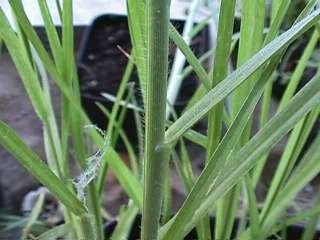
Kikuyu grass
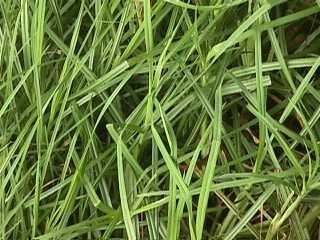
Kikuyu sward
When ungrazed, Kikuyu can competitively exclude many other species.
Pennisetum clandestinum
A sub-tropical perennial grass, most commonly found in pastures north of Auckland or further south in coastal regions. Grows in a wide variety of habitats, often forming a dense sward smothering and excluding other species. Reduced winter growth and feeding value compared with ryegrass, but better moisture-use efficiency for summer growth.
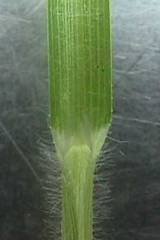
Kikuyu leaf
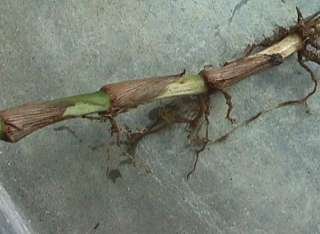
Kikuyu stolon
Dead leaves or leaf bases at each node appear further from the tip, as seen here.
Vegetative identification
- Leaves are hairy, particularly the sheath.
- The ligule is a fringe of distinct hairs (2 to 3 mm).
- Distinctive thick stolons with six to 10 live leaves on each. Stolons creep on or just above the ground, often showing traces of green pigment and typically five to 10 live leaves at the growing end.

Kikuyu stigma
Seedhead
- Flowering is uncommon but is sometimes seen in mown lawns. The leaf sheath can enclose the flowers.
- The only visual evidence of flowering is the appearance of stigmas or anthers on long filaments.
Meadow foxtail
Meadow foxtail
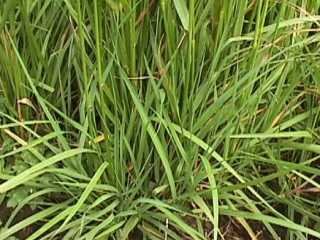
Meadow foxtail plant
Alopecurus spp.
New Zealand has several species of foxtail, treated here as a group. Usually found in low-lying or wet areas. In Palmerston North, foxtail is the first grass to flower in the spring, producing seedheads as early as September.

Meadow foxtail leaves
Vegetative identification
- Leaves break easily but have silica teeth at the edges and are harsh to touch.
- Leaves are hairless, lightly ribbed and usually a dark green colour.

Meadow foxtail seedheads
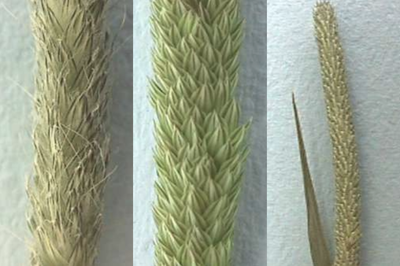
Seedhead comparison: foxtail (left), phalaris (centre) and Timothy (right)
Seedhead
- Seedhead is a cylindrical compacted panicle. Each floret with a single seed and fine awn arising from the base of the lemma.
- A single awn protruding from each spikelet.
- The seedheads of Timothy and phalaris are similar to meadow foxtail, but without the fine awns.
Paspalum
Paspalum
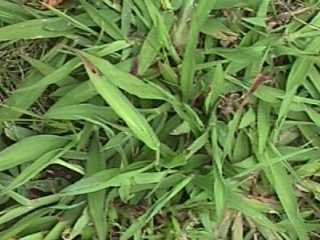
Paspalum in dense carpet form
Paspalum dilatatum
A sub-tropical grass, found in pasture throughout the North Island and northern part of the South Island, particularly on moist, fertile soils. Like Kikuyu, paspalum has a "C4" photosynthesis pathway, which confers greater water-use efficiency and allows paspalum plants to stay green longer than temperate "C3" grasses during drought. Paspalum is winter dormant but aggressive in summer and autumn and often displaces other species. The plant may be tall if ungrazed or form a dense carpet in mown lawns.
Other species
- Mercer grass (Paspalum distichum) has a pair of racemes in a V-shape.
- Vasey grass (Paspalum urvillei) is a tall growing species (to 2 m high) often seen in Northland.
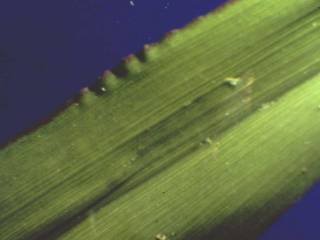
Paspalum leaf
Vegetative identification
- Leaves are distinctive, very broad, often with a red or crinkled margin, sometimes both.
- In lawns, plants prostrate and spread by horizontal underground true stems, showing clear leaf scars.
- In roadside plants, tillers are large, with long hairs at the edges of the upper part of the leaf sheath and shorter, sparser hairs below.
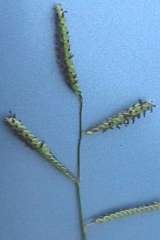
Paspalum seedhead
Seedhead
- Seedhead consists of three or more racemes branching off a central stem.
- Jet black stigmas are often visible and sticky.
- Spikelets have a disc-like shape.
Perennial ryegrass
Perennial ryegrass
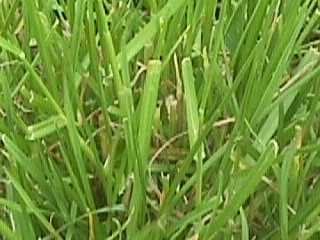
Perennial ryegrass
Lolium perenne
Perennial ryegrass comprises some 90% of new pasture sowings in New Zealand and forms the basis of most improved pastures. It requires high fertility and shows only moderate drought tolerance.
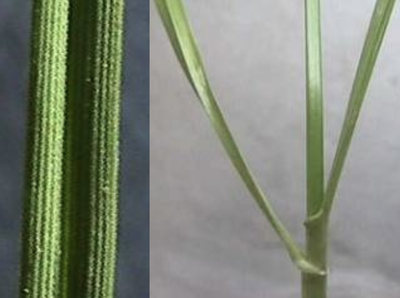
Perennial ryegrass leaf

Perennial ryegrass (left) Italian ryegrass (right). Note: perennial ryegrass has a narrower lamina and folded emerging leaf

The red tiller base of ryegrass. Red colouration caused by anthocyanin pigments varies from almost absent to a deep red purple
Vegetative identification
- Leaf blade with 'corrugated iron' ribs on the upper surface, a deep v-shaped groove at the midrib and a shiny lower surface.
- A folded emerging leaf distinguishes the plant from the rolled emerging leaf of Italian ryegrass.
- Dead outer leaves can conceal the red-coloured sheath base.
- Chocolate-coloured dead leaf bases with straw coloured-veins provide another way to recognise perennial ryegrass.
- Auricles are small and may be absent.

Perennial ryegrass seedhead
Seedhead
- Spikelets of four to eight florets (seeds) are arranged alternately along an unbranched stem (a spike).
- Awns absent from tips of seed lemmas (present in Italian ryegrass).
- Seedheads of couch look similar but have a blue-green colour with the spikelets turned 'flat-side' towards the stem.
Phalaris
Phalaris
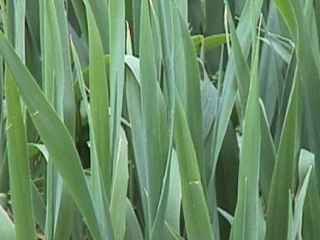
Phalaris plant
Phalaris aquatica
Found mainly in lowland pastures on fertile soils, phalaris is a perennial grass. Tolerant to heavy wet soils in winter and survives severe summer droughts. Fresh regrowth can at times be dangerous to livestock due to the presence of toxic alkaloids.
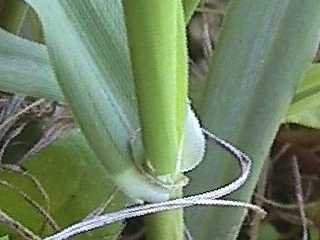
Phalaris leaf and ligule
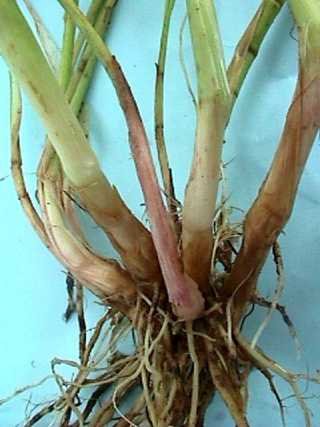
Phalaris rhizomes
Notice the thick, tough, underground stems (tuberous at the base) with pink-tinged scale leaves at the base
Vegetative identification
- Distinctive flat wide bluish-coloured leaf.
- Hairless ligule three to 10 mm long, membranous, often split.
- If ungrazed plant may grow as high as 2 m.
- Short thick underground rhizomes with a characteristic pink colour, especially on veins of underground scale leaves.
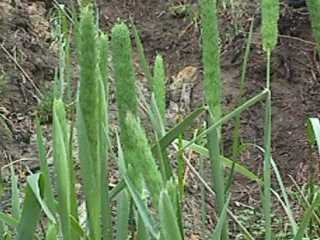
Phalaris seedheads

Seedhead comparison: foxtail (left), phalaris (centre) and Timothy (right)
Seedhead
- Seedhead is a dense cylindrical compacted panicle five to 12 cm long.
- Timothy and meadow foxtail have similar seedheads to phalaris.
Prairie grass
Prairie grass

Prairie grass
Bromus willdenowii
A perennial grass adapted to high fertility, free draining soils. Highly productive but does not persist well in wetter soils. Susceptible to insect pests and fungal diseases.
Prairie grass hay is reportedly strongly preferred by horses.

Prairie grass leaf, sheath and ligule
Vegetative identification
- The sheath is hairy and dense, though some commercial cultivars can be almost hairless.
- Membranous ligule is large with a jagged end. No auricles.
- The emerging leaf may be rolled or folded.
- Leaves harsh to touch.
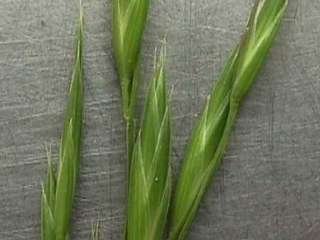
Prairie grass seedhead
Seedhead
- The seedhead is a large, open panicle with large flattened spikelets containing four to eight florets.
- Flowering occurs over a prolonged period from October. Seedheads can be found almost throughout the year.
Ratstail
Ratstail
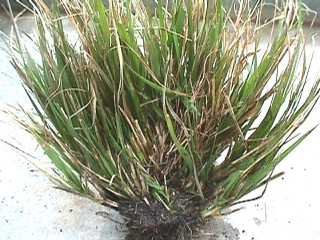
Ratstail plant
Sporobolus africanus
The plant forms dense tufts. Often seen on steeper hill faces within a paddock of variable topography or in other challenging environments. When mown, leaf fibres are not cut cleanly and are visible at the ends of the leaves. Tough roots hold the plant and are extremely difficult to pull out.
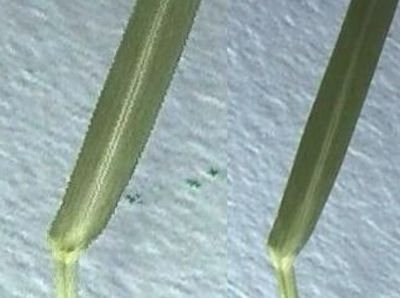
Ratstail leaf
Vegetative identification
- Leaf greyish green, shiny, tough, with a white central groove in the lower part.
- Ligules have a fringe of short hairs.
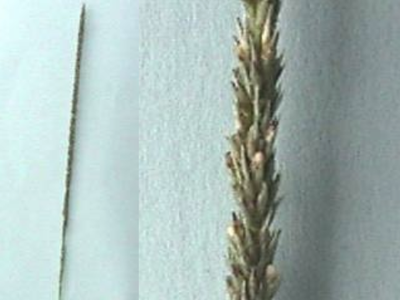
Ratstail seedhead
Seedhead
- The distinctive seedhead contains small one-seeded spikelets on short branches.
- Branches are pressed closely to the stem, giving a 'rat's tail' appearance.
- Older seedheads can open to form a compact panicle with short branches.
Rough-stalked meadow grass
Rough-stalked meadow grass

Rough-stalked meadow grass plant
Poa trivialis
A perennial grass common in the dense pasture on fertile, moist soils where it fills spaces not occupied by ryegrass or white clover.
This plant has a shallow root system. Above-ground parts die back in summer and re-establish from crowns after autumn rain.
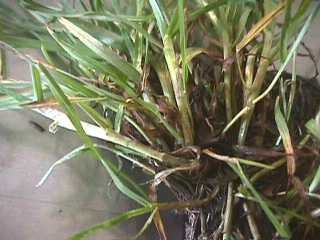
Rough-stalked meadow grass leaves and stolons
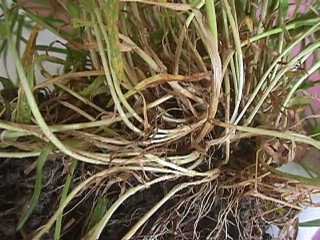
Stolon development in a mature Poa trivialis plant
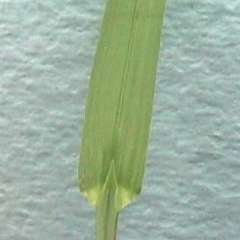
Leaf blade of Poa trivialis. Note wide central groove at the midrib, often showing parallel 'tramlines' at each side.
Vegetative identification
- The presence of stolons, greater height (up to 40 cm) and leaf blades broader at the base and narrowing towards the tip distinguish this plant from Poa annua.
- Stems are often silvery, with a colour-less "blue" than Poa pratensis and less "yellow" than Poa annua.
- Shiny leaves below, almost like perennial ryegrass.

Three common poa species, Poa pratensis (left), Poa trivialis (middle) and Poa annua (right)
Leaf comparison of three common poa species
Poa pratensis is known in the USA as Kentucky bluegrass and has a darker colour than Poa trivialis. Poa annua is a yellow-green compared with Poa trivialis.
Poa pratensis has parallel-sided leaves, whereas the leaves of Poa trivialis taper along their length. Poa annua leaves often have patches of crinkled surface (see lower right).
Many poa species, including Poa annua and Poa pratensis, have canoe-shaped leaf tips (not shown here).
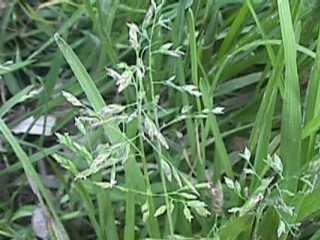
Rough-stalked meadow grass seedhead
Seedhead
- An open panicle.
- Poas differ from fescues in the shape of the spikelets. In poas, there is a sharp fold or 'keel' at the back of glumes and lemmas. In fescues, the backs of seeds form a smooth curve in cross-section.
- Poas differ from the browntop group in the number of florets per spikelet: several in poa and one in browntop.
Summer grass
Summer grass
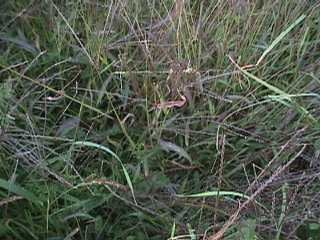
Summer grass plant
Digitaria sanguinalis
A summer-annual sub-tropical grass. The plant forms dense patches on roadsides or waste ground where it has the opportunity to seed, and for this reason, is regarded as a weed.
Found throughout the North Island and much of the South Island and at times a troublesome invader of grazed pastures.
Several species of Digitaria occur in New Zealand and are easily confused with each other.
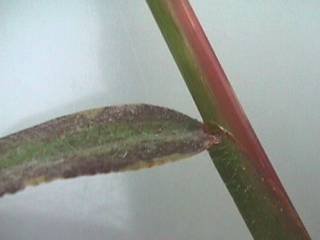
Summer grass leaf
Vegetative identification
- Leaves and stems often appear with significant patches of red-purple pigment.
- Leaves are broad and comparatively short, widest about 10 to 20 mm above the ligule, then tapering to a point.
- Short, coarse hairs cover the leaves and sheaves.
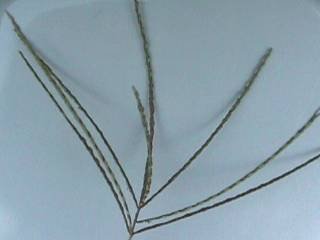
Summer grass seedhead
Seedhead
- Seedhead consists of several racemes branching from more or less the same point to give the shape of a bird's foot.
Sweet vernal
Sweet vernal
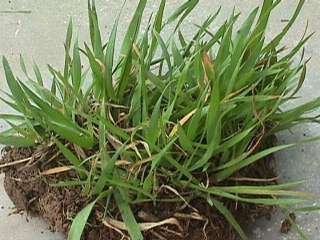
Sweet vernal plant
Anthoxanthum odoratum
A perennial grass commonly included in seed mixes in earlier years and persisting in many older pastures. Found in low fertility inter-track areas in hill country or where the soil is dry in summer. For example, the stony soils of river plains.
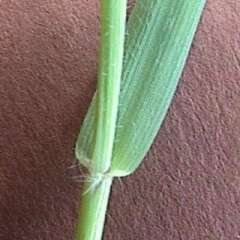
Sweet vernal leaf
Vegetative identification
- In good light, a distinctive tuft of hairs appears at the base of the leaf blade where the auricle would be if present.
- Leaves are broad in relation to their length and have a bluish colour. Very sparsely hairy — hairs hard to see.
- Leaves often have a "hay smell" when crushed, attributable to coumarins (aromatic organic compounds).
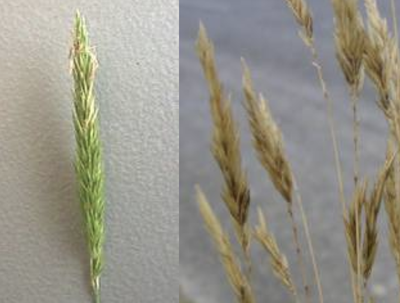
Sweet vernal seedhead
Seedhead
- A distinctive spike-like compact panicle.
- Two sterile florets at the base of each developed seed are visible with low power magnification.
- Empty glumes remain for some months after seed fall.
Tall fescue
Tall fescue
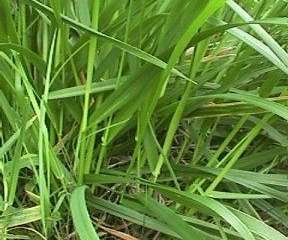
Tall fescue grass
Lolium arundinaceum
A tall, erect perennial grass with seedheads up to 1.5 m tall found in lowland pasture and waste areas. Tolerant to wet soils yet withstands drought well. A secondary grass species in New Zealand, useful in drier, warmer areas due to deeper rooting and maintaining growth at higher temperatures compared with perennial ryegrass. MaxP endophyte produces the alkaloids peramine and loline and is safe for cattle.
Tall fescue has a large tiller size and is sensitive to hard or frequent grazing. It is widespread along roadsides.
The preferred Latin name is now Lolium arundinaceum but still traded internationally as Festuca arundinacea.
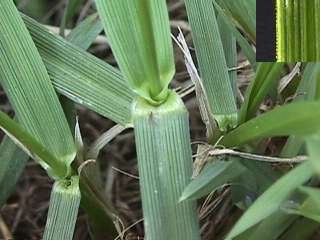
Tall fescue leaf
Vegetative identification
- Leaves are dark emerald-green with distinct, coarse ribs on the upper surface and a glossy lower surface.
- Related to ryegrass and may have traces of red pigment at the tiller base.
- Short bristles along the edge of the collar (the region where the leaf blade meets the sheath) are visible with magnification.
- In most cultivars, leaves are harsh to the touch. Feel fine silica teeth when fingertips run down leaf margins.
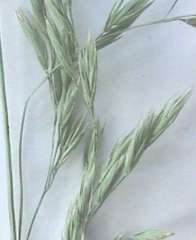
Tall fescue seedhead
Seedhead
- Seedhead is an open, much-branched panicle with twin but unequal length branches carrying five to 15 spikelets. Each spikelet contains three to 10 florets.
Timothy
Timothy
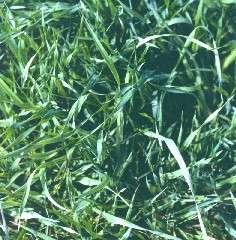
Timothy grass
Phleum pratense
Sown as a forage grass in areas with colder winters and mild, moist summers, such as Canada. In New Zealand, of some interest in Southland, where it is sometimes sown and has a reputation for compatibility with white clover and for producing good animal live-weight gains.
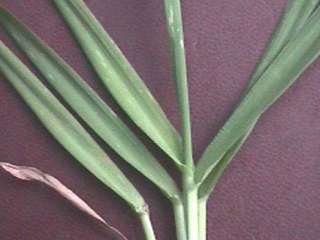
Leaves of Timothy grass

Timothy stem base
Notice the swelling of internodes (seen mainly in older tillers). Swollen segments contain stored carbohydrates.
Vegetative identification
- Leaves broad, a bluish-green colour with a rather indistinct midrib.
- Ligules are very short and plant without hairs.
- The diagnostic feature is a creamy-white colour at the base of the pseudostem, with swelling of internodes at stem bases, especially in older tillers.
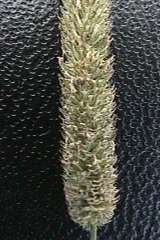
The seedhead of Timothy grass

Seedhead comparison: foxtail (left), phalaris (centre) and Timothy (right)
Seedhead
- Seedhead is a dense, spike-like panicle of approximately uniform diameter along its whole length.
- Pointed glumes give the end of the spikelet a flat appearance with a distinctive double tip, like ears.
- Timothy is distinguished from phalaris and meadow foxtail by the fine detail of its spikelets.
Yorkshire fog
Yorkshire fog
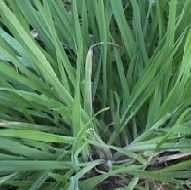
Yorkshire fog grass
Holcus lanatus
Yorkshire fog is a perennial grass found in lowland and hill country pastures. Provided the soil is reasonably moist, this grass is tolerant of a wide range of fertility and acidity conditions and colder conditions found at medium altitudes.
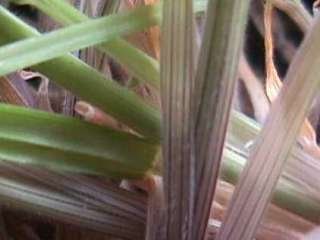
Purple veins at the base of the Yorkshire fog grass
Vegetative identification
- Short hairs on the leaf blade and sheath are numerous and easily visible.
- Soft to touch and sometimes known as "velvet grass", leaves tear easily.
- Veins at the base of the leaf sheath are distinctly purple with white colour between, giving a "striped pyjama" pattern.
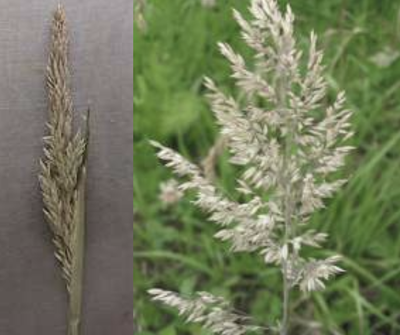
Yorkshire fog seedheads
Seedhead
- Seedhead is a distinctively shaped panicle with short branches.
- The structure of spikelets is similar to oats – two florets per spikelet, with a short, hooked awn arising from the back of the lemma.
Legumes
Lotus
Lotus
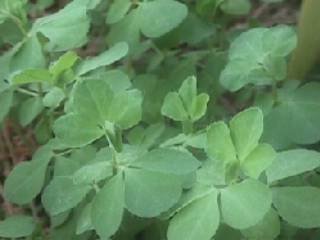
Lotus pedunculatus
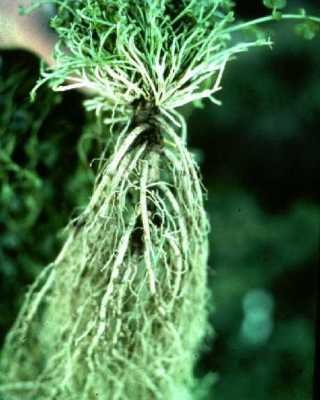
Underground rhizomes of the lotus plant.
Lotus pedunculatus
Lotus is tolerant of wet or acid soils and shade and is not competitive in better environments. The plant has underground rhizomes, which can store carbohydrates in autumn for overwintering, making it an ideal plant for the South Island high country. It contains condensed tannins which improve protein absorption of grazing animals.
At times, the former Latin names Lotus uliginosus or Lotus major are used.
Other species
Several other species of Lotus also occur in New Zealand, on roadside verges and waste ground. Lotus corniculatus (birdsfoot trefoil) is now commercially available and recommended for use on less fertile soils in regions with warm dry summer conditions.
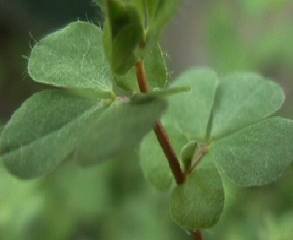
Stalk of a lotus plant
Vegetative identification
- Leaves, at first glance, appear to have five leaflets. The two stipules at the base of the petiole have a leaf-like appearance.
- Leaves range from almost hairless to quite hairy.
- Stems unable to support their weight, at first ascending, then if not grazed, sprawling loosely on the ground in an interwoven mat.
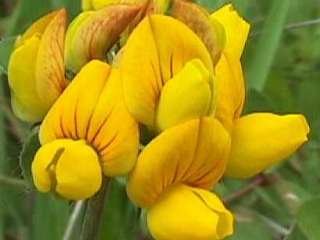
Lotus inflorescence
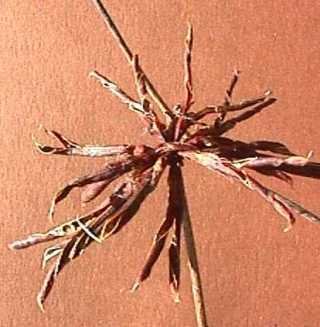
Lotus pods after shedding seed
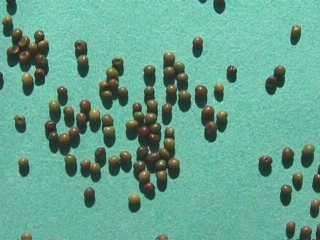
Lotus seeds
Flower and seeds
- Flowers are bright yellow in clusters of five to 15.
- Pods are straight, cylindrical and pointed, attached to a central point like the spokes of a wheel.
- Seeds are smaller than those of white clover, almost spherical, yellow-orange or red-brown to grey-green in colour.
Lucerne
Lucerne

Photo taken near Atlanta, Georgia, USA, on a dairy farm where cows are stall-fed lucerne silage as a main diet.
Medicago sativa
Known as alfalfa in the USA, lucerne is probably the most common of the forage legume crops. It has a deep tap root and extracts soil moisture to a greater depth than most other crops, giving it comparatively good summer growth in drier climates.
Lucerne is winter dormant and can be prone to pests and diseases.
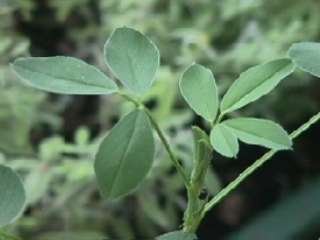
Leaves of the lucerne plant

Note the point or mucro at the end of the leaf mid-vein and the extended stalk to the middle leaflet.
Vegetative identification
- In the Medicago genus (including lucerne), the stalk of the middle leaflet is about 3 to 5 mm long, separating it from the two lateral leaflets.
- Leaves are about three times longer than broad and the mid-vein often ends in a fine point.
- Plant erect up to 0.8 m in height, but usually around 45 to 60 cm.
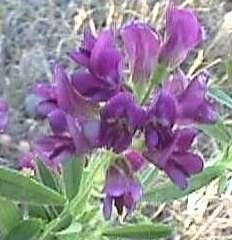
Lucerne in flower
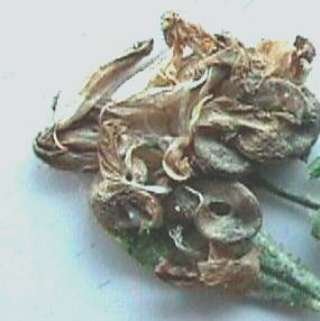
Lucerne seedhead

Lucerne seeds
Flower and seeds
- Small clusters of purple flowers.
- Pods curled into a spiral shape.
- Seeds are a little larger than white clover seeds and more kidney-shaped, variable in colour, usually yellow-brown.
Red clover
Red clover
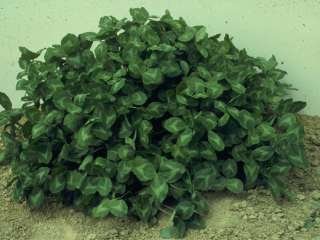
Red clover plant
Trifolium pratense
Red clover is often included as the second legume in new pasture sowings (especially where summer drought occurs). It is also used as a specialist seed or hay crop. Poor winter growth. Tap rooted and typically persists in pastures for only about five years. Older cultivars contain oestrogenic compounds (for example, formononetin).
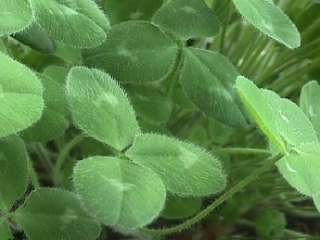
Red clover leaves
Vegetative identification
- Leaves are hairy, darker and more oval than white clover, but with some variation in shape.
- Leaves are usually a little larger than other clovers, usually but not always with a paler "v" mark.
- Plant erect, sometimes approaching 1 m in height.

Red clover inflorescence (group of florets)
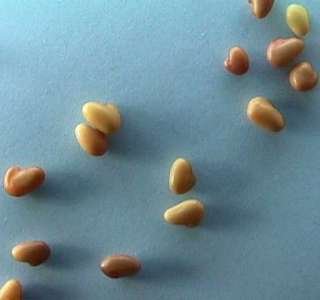
Red clover seeds
Flower and seeds
- Clusters of 15 to 30 reddish-purple flowers form an aspherical-shaped head.
- Flower heads are elevated on stems and slower maturing than white clover.
- Seeds are larger than those of white clover (especially in tetraploid varieties), similar in shape, but darker in colour.
Strawberry clover
Strawberry clover
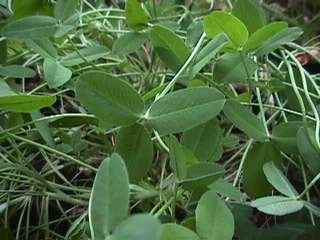
Strawberry clover plant
Trifolium fragiferum
Strawberry clover is an uncommon species of clover, most often seen in coastal sites where it can displace white clover as the dominant legume in mixed grass-cover swards. This species is more tolerant of salt and wet soils than white clover. Sometimes commercial cultivars are available.
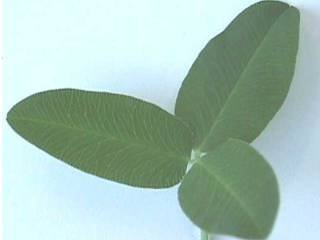
Strawberry clover trifoliate leaf
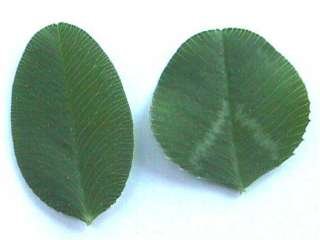
Strawberry clover leaflet (left) and white clover leaflet (right)
Vegetative identification
- Leaves are hairless.
- Leaves are similar to white clover but slightly more oval, and the veins are more pronounced.
- The leaf surface between veins is undulating in white clover and smooth and velvety in strawberry clover.

Strawberry clover swollen seedhead
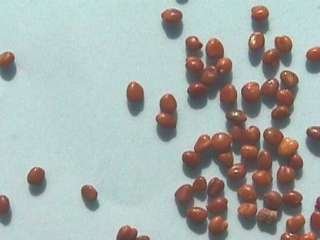
Strawberry clover seeds
Flower and seeds
- Flower heads are usually a little smaller than white clover.
- Flowers have a pinkish tinge, and flower parts swell on maturity to a very distinctive ball shape.
- Seeds are similar in size and shape to white clover but a little darker in colour.
Subterranean clover
Subterranean clover

Subterranean clover plant
Trifolium subterraneum
Subterranean clover is a winter annual, where plants flower, set seed and die in November/December each year. Seeds germinate and recolonise after an autumn rain, usually in March/April. Naturally dominant on warmer, drier slopes and free-draining alluvial flats or lower rainfall areas. Older cultivars have oestrogenic compounds that reduce the fertility of grazing animals.
Subterranean clover forms the main pasture legume in many parts of inland Victoria, Australia.

Subterranean clover leaf
Vegetative identification
- The leaflets are hairy and heart-shaped.
- Leaves often have small black spots or lines.
- Plants are small in autumn, growing to 30 cm or more in diameter, with stems creeping along the ground by late winter.
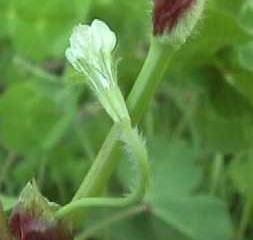
Subterranean clover flower
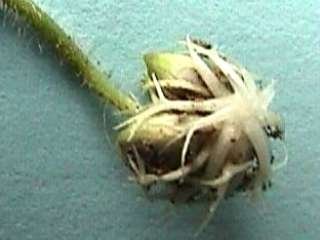
Subterranean clover seed burr
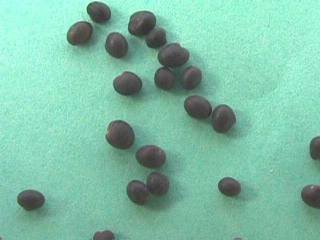
Subterranean clover seeds
Flower and seeds
- Flowers are whitish, in small clusters of 2 to 5 florets, not a round head.
- On maturity flower stalks form a burr and turn and curl downwards to bury the seed.
- Seeds are large compared with other clovers, almost spherical, and blackish.
White clover
White clover
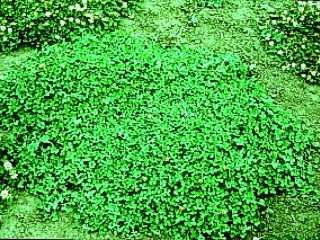
Smaller leaved white clover sward

White clover plant and flower
Trifolium repens
Almost always included with new pasture sowings as the main legume. Many cultivars are available in New Zealand. Cultivars differ in seasonal growth (winter active or dormant) and leaf size and stolon density (smaller leaf types are preferred for sheep pastures and larger leaf types for dairy pastures). Like other legumes, fixes nitrogen from the atmosphere with rhizobium bacteria: 5 to 200 kg N/ha/year. Stoloniferous habit makes plants "self-replacing" in the sward.

White clover stolon (creeping stem) and leaves
Vegetative identification
- Leaves are hairless and round to oval, extremely variable in size and colour.
- Stipules are scale-like, hairless, small and pointed.
- Leaves usually have a whitish "v" mark, and sometimes have red flecks.
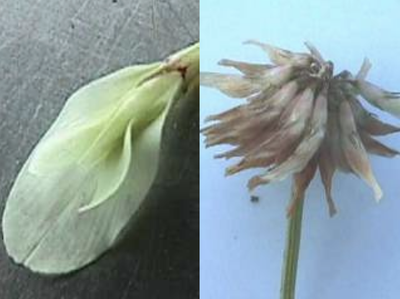
White clover floret (left) inflorescence (right)

White clover seeds
Flower and seeds
- Clusters of typically 40 to 60 white florets form a spherical-shaped head.
- Florets turn brown and hang from the head as the seed matures.
- Seeds are small, yellow-red to orange-brown and distinctly heart-shaped.
Cereals
Barley
Barley
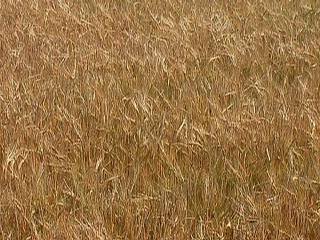
A barley crop ready for harvest
Hordeum vulgare
Barley is a C3 cereal grown mostly as an animal feed (for example, cv. Fleet) and for the production of malt used in the brewing of beer. It's usually the most common cereal crop grown in New Zealand.
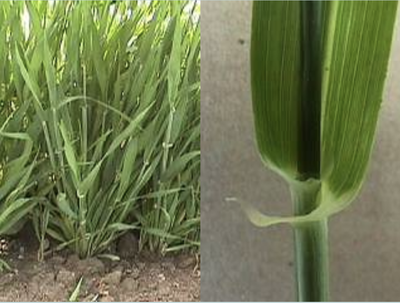
Green barley crop (left) single stem of barley (right)
Vegetative identification
- A large tiller, normally sown in rows 15 cm apart.
- Very distinct auricles clasping the stem.
- The plant is usually only sparsely hairy.
- Ligule around 3 mm long.

Barley seedhead: two-row (left) and six-row (right)
Seedhead
- Most New Zealand cultivars are two-row types. Six-row types are common overseas.
- Spikelets in groups of three alternate sides of the stem. One spikelet contains one floret. All three develop in six-row barley, only the centre one develops in two-row barley.
- Long straight awns are nearly always present (although some awnless cultivars now exist) and awn photosynthesis contributes significantly to grain fill.
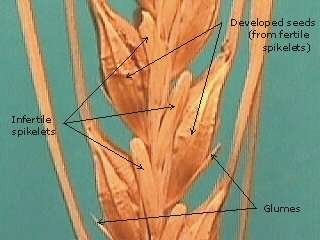
Side view of a two-row barley spikelet
Two-row barley seedhead
In two-row barley, one spikelet of each group of three is fertile. The fertile spikelet is between two infertile spikelets, so the ear appears to contain two rows of grain.
The infertile spikelets are also in rows, and when viewed from the side, the ear appears to have "chicken tracks" running up it.
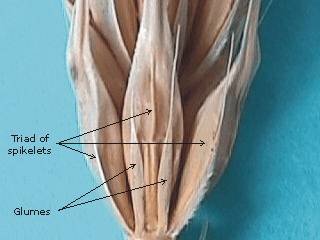
Six-row barley spikelet
Six-row barley seedhead
In six-row barley, all the spikelets are fertile, so the seed is crowded around the ear. The lateral grains are cramped and twisted, while the central grain is normal size, resulting in a sample of harvested grain uneven in shape and size.
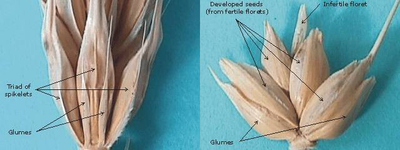
Barley seedhead (left) wheat seedhead (right)
Comparison of barley to wheat
Each barley spikelet contains only one floret, so only one grain may develop per spikelet. In wheat, one spikelet contains two or more florets. Therefore, in one spikelet, more than one grain will develop, but not all florets will be fertile.
Maize
Maize
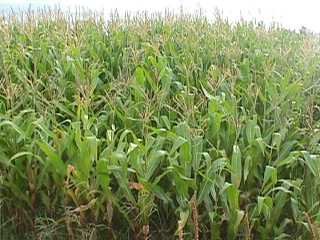
A crop of maize
Zea mays
Maize is a C4 cereal food grain that is also used as a breakfast cereal and in snack products, (for example, corn chips). Sown in spring when soil temperatures reach a minimum of ten degrees celsius. Intolerant to cool temperatures.
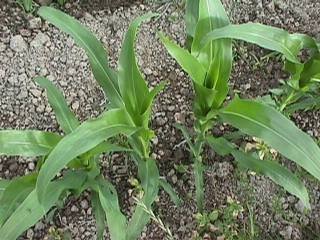
Maize plants
Vegetative identification
- A vegetative plant, usually a very large single tiller sown in rows 75 cm apart.
- Leaves often > 50 mm in width.
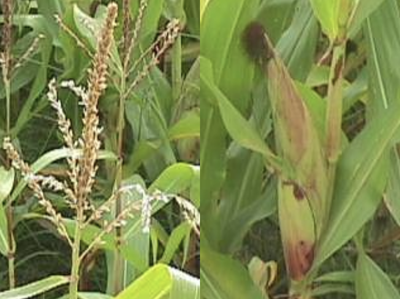
Maize male tassel flowerhead (left) and female cob (right)
Seedhead
Male and female flower parts are separate. The male tassel is located at the top of the plant, while the female cobs in leaf axils are lower down on the plant.
Oat
Oat
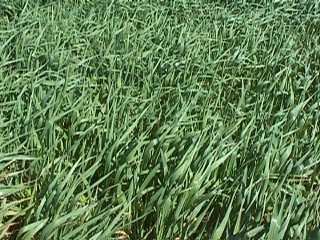
Oat crop
Avena sativa
Oat is a C3 cereal that is mostly grown as animal feed and for breakfast cereals.
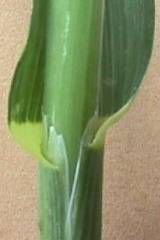
Oat grass ligule
Vegetative identification
- A large tillered grass, sown in rows 15 cm apart.
- Leaves twisted anticlockwise at the seedling stage.
- Broad leaves with no auricle, hairless or almost hairless, slightly bluish-green colour.
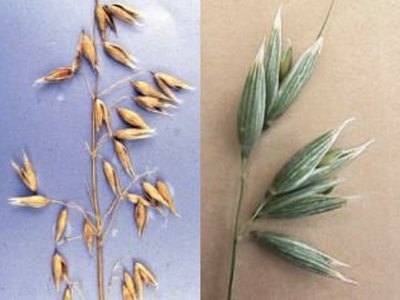
Oat grass seedheads
Seedhead
- The seedhead is an open panicle. Spikelets usually with two to three fertile florets.
- A "coarse" grain with variable colour (ranging from almost black to white).
Wheat
Wheat

Wheat growing in a field
Triticum aestivum
Wheat is a C3 cereal used for bread and pasta and animal feed. Crops are sown either in spring (cultivars not requiring vernalisation) or autumn, especially in drought regions.
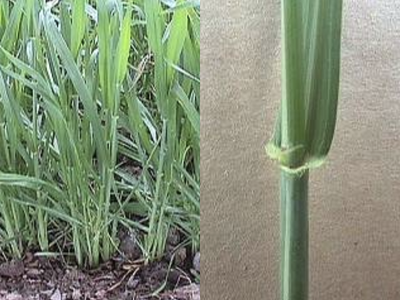
Wheat plants (left) and grass stalk (right)
Vegetative identification
- A large tillered grass, sown in rows 15 cm apart.
- Distinct auricles.
- The plant usually has a distinctly hairy sheath, blade base and auricles.
- Ligule about 1 mm long.

Wheat seedheads
Seedhead
- One spikelet is a "fishtail" arrangement of two or more florets (compare with barley).
- The seedhead may be awned or awnless depending on the cultivar.
- Awns (if present) are on the lemma, not the glumes
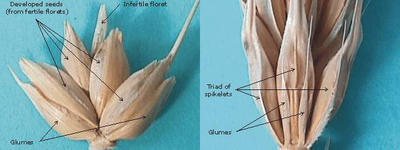
Wheat seedhead (left) barley seedhead (right)
Comparison of wheat to barley
In wheat, one spikelet contains two or more florets. Therefore, in one spikelet, more than one grain will develop, but not all florets will be fertile. Each barley spikelet contains only one floret, so only one grain may develop per spikelet.
Pasture identification
To recognise different pasture grasses and clovers, we often use colour, leaf shape and texture, and seed-head morphology.
Leaf colour
Leaf colour
Chlorophyll pigments in different grasses give each a characteristic hue. In particular, if we use perennial ryegrass as our reference (we will call this colour "emerald" green), we will find that some grasses are more yellow and some grasses are bluer in their leaf colour. The human eye can learn to recognise these colour differences, often when several metres away from the plant in question.
However, note that colour differences are not infallible identification criteria because nutrient or drought stresses also result in colour change. With practice, you can distinguish stress-induced colour change from species pigmentation.
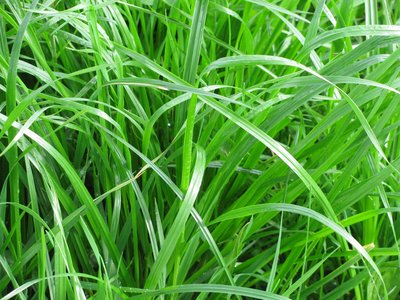
Emerald green
This example is perennial ryegrass
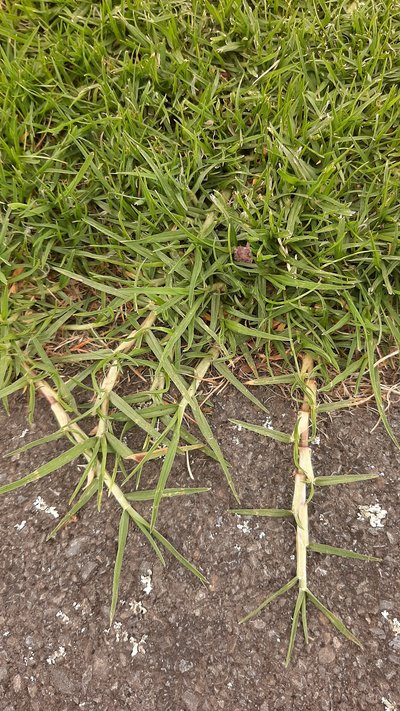
Yellow green
This example is Kikuyu
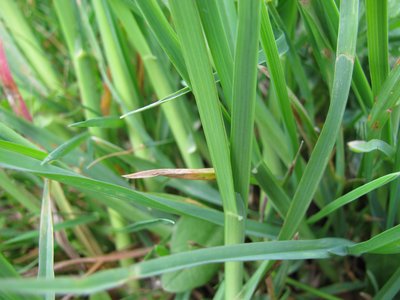
Blue green
This example is cocksfoot
Light reflection
Light reflection
Not only do leaves of different plants have different colour hues, but they also reflect light differently because of differences in cuticle structure and composition. In particular, some plants are notable for their shiny leaf surface, while others have dull leaves.
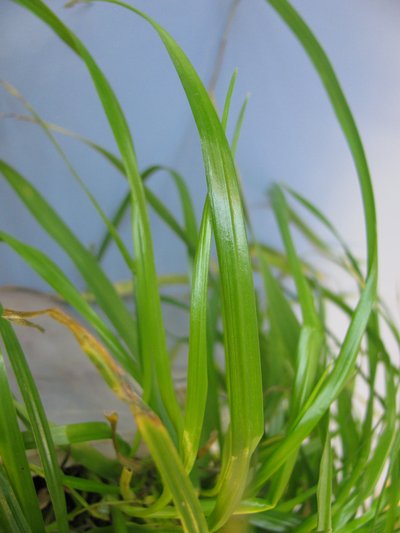
Example of a shiny leaf surface
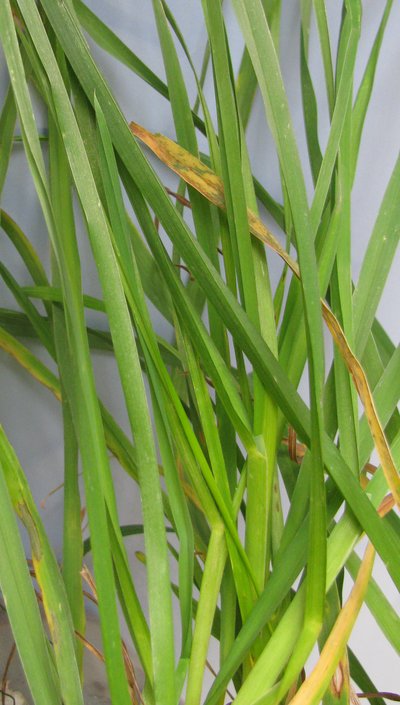
Example of dull leaves
Stem bases
Stem bases
Stem bases of pasture plants may also show distinctive colours. These include shades of purple (Yorkshire fog - purple veins), red (perennial ryegrass - red stem base), cream crested dogstail - where green stem colour fades to cream), and chocolate brown (dead leaves of fine fescue and perennial ryegrass).
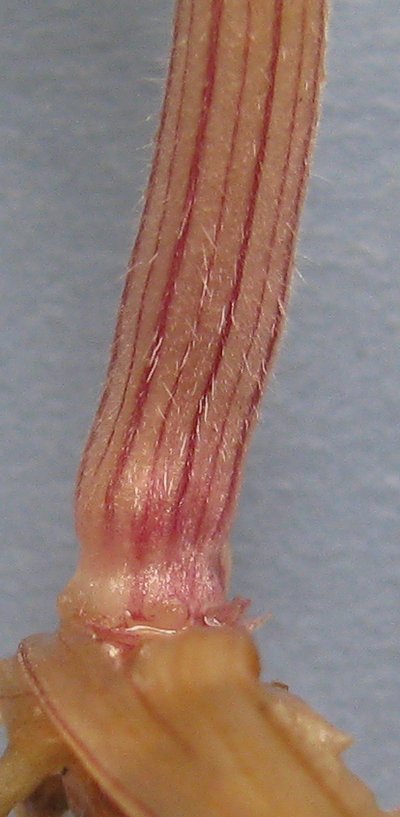
Purple
Purple veins of Yorkshire fog.

Red
Red stem of perennial ryegrass.
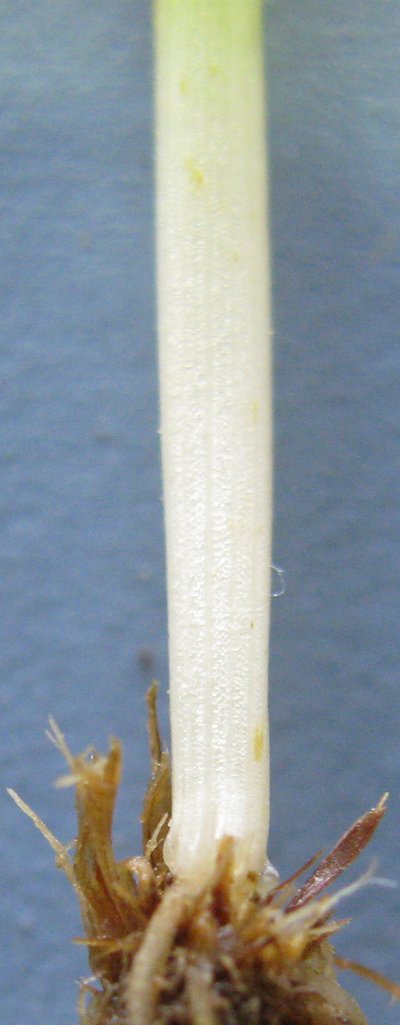
Cream
The green stem colour that fades to cream for the crested dogstail.

Chocolate-brown
The dead leaves of fine fescue and perennial ryegrass.
Classifying grasses
Consider the following questions when identifying pasture grass groups:
- Is the grass ryegrass or look similar to ryegrass? (ribs on the leaf, upper surface)
- Does the grass have visible hairs on the leaf blade and/or sheath?
- Is the grass a poa? (three common species)
If the answer to these questions is No, the grass should be dull and bluish green which places it in the Dull Grasses group.
Ryegrass
Ryegrass
- perennial ryegrass
- Italian ryegrass
- tall fescue
- crested dogstail
- meadow foxtail
Grasses with hairs
Grasses with hairs
- Yorkshire fog
- sweet vernal
- paspalum
- Kikuyu
- barley grass
- prairie grass
- couch
- summer grass
Dull grasses
Dull grasses
- browntop
- creeping bent
- cocksfoot
- phalaris
- Timothy
The few common types of grass which do not fall into one of these groups tend to be rather distinctive.
- fine fescue
- ratstail
- danthonia
- floating sweet grass
